PONTIAC FIERO 1988 Service Repair Manual
Manufacturer: PONTIAC, Model Year: 1988, Model line: FIERO, Model: PONTIAC FIERO 1988Pages: 1825, PDF Size: 99.44 MB
Page 891 of 1825
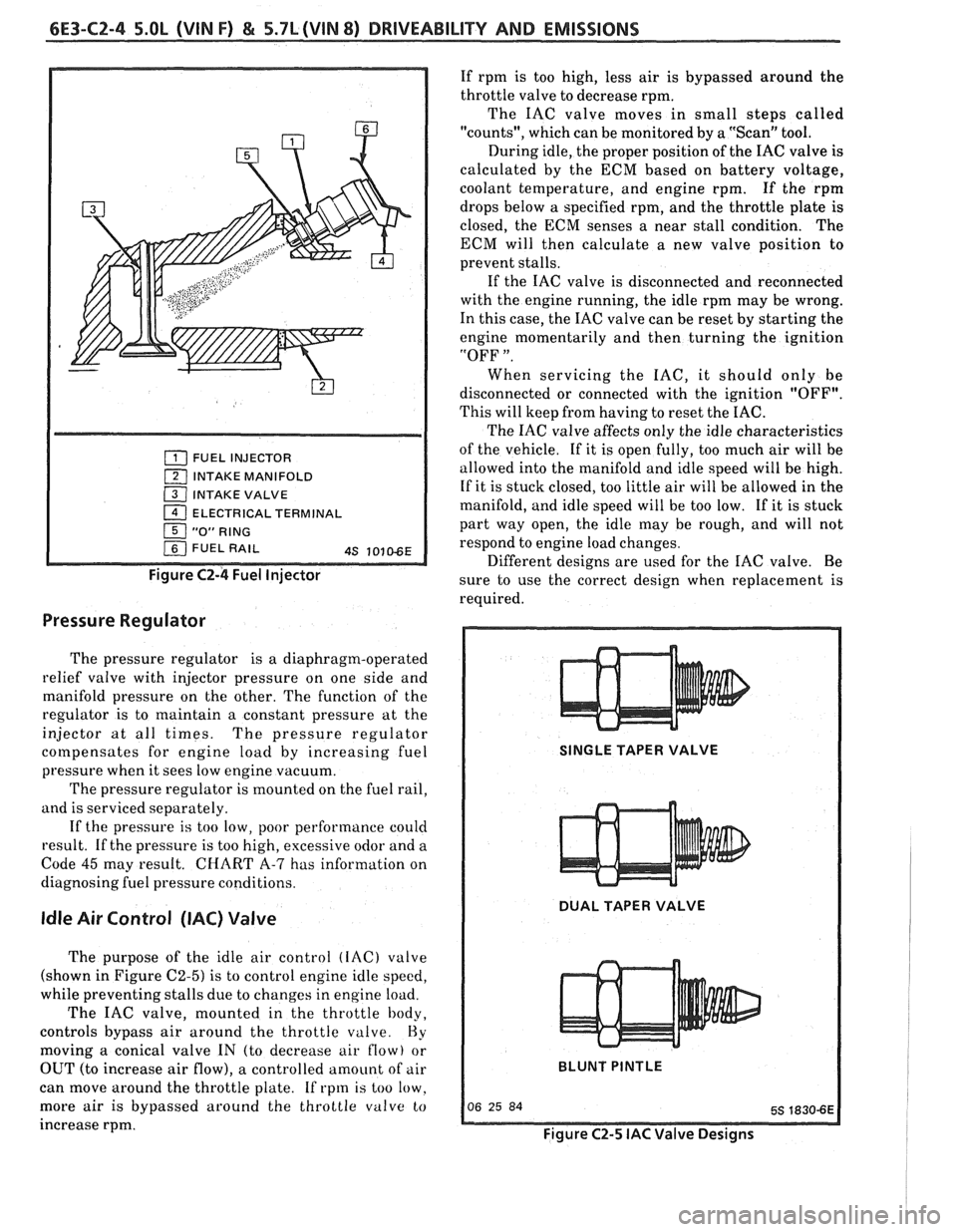
6E3-CZ-4 5.OL (VIN F) & 5.7L(VIN 8) DRIVEABILITY AND EMISSIONS
FUEL INJECTOR
1 INTAKE MANIFOLD
( INTAKE VALVE
1 ELECTRICAL TERMINAL
Figure C2-4 Fuel Injector
Pressure Regulator
The pressure regulator is a diaphragm-operated
relief valve with injector pressure on one side and
manifold pressure on the other. The function of the
regulator is to maintain a constant pressure at the
injector at all times. The pressure regulator
cotnpensates for engine load by increasing fuel
pressure when it sees low engine vacuum.
The pressure regulator is mounted on the fuel rail,
and is serviced separately.
If the pressure
is too low, poor performance could
result. If the pressure is too high, excessive odor and a
Code
45 may result. CHART A-7 has information on
diagnosing fuel pressure conditions.
Idle Air Control (IAC) Valve
The purpose of the idle air control (IAC) valve
(shown in Figure
C2-5) is to control engine idle speed,
while preventing stalls due to changes in engine load.
The IAC valve, mounted in the throttle body,
controls bypass air around the throttle
valve. Hy
moving a conical valve IN (to decrease air flow) or
OUT (to increase air flow), a controlled amount of air
can move around the throttle plate. If rpm is too low.
more air
is bypassed around the throttle valve to
increase rpm. If
rpm is too high, less air is bypassed around the
throttle valve to decrease rpm.
The IAC valve moves in small steps called
"counts", which can be monitored by a "Scan" tool.
During idle, the proper position of the IAC valve is
calculated by the ECM based on battery voltage,
coolant temperature, and engine rpm. If the rpm
drops below
a specified rpm, and the throttle plate is
closed, the ECM senses a near stall condition. The
ECM will then calculate a new valve position to
prevent stalls.
If the IAC valve is disconnected and reconnected
with the engine running, the idle rpm may be wrong.
In this case, the IAC valve can be reset by starting the
engine momentarily and then turning the ignition
"OFF
".
When servicing the IAC, it should only be
disconnected or connected with the ignition "OFF".
This will keep from having to reset the IAC.
The IAC valve affects only the idle characteristics
of the vehicle. If it is open fully, too much air will be
allowed into the manifold and idle speed will be high.
If it is stuck closed, too little air will be allowed in the
manifold, and idle speed will be too low. If it is stuck
part way open, the idle may be rough, and will not
respond to engine load changes.
Different designs are used for the IAC valve. Be
sure to use the correct design when replacement is
required.
SINGLE TAPER VALVE
DUAL TAPER VALVE
BLUNT
PINTLE
Figure C2-5 IAC Valve Designs
Page 892 of 1825
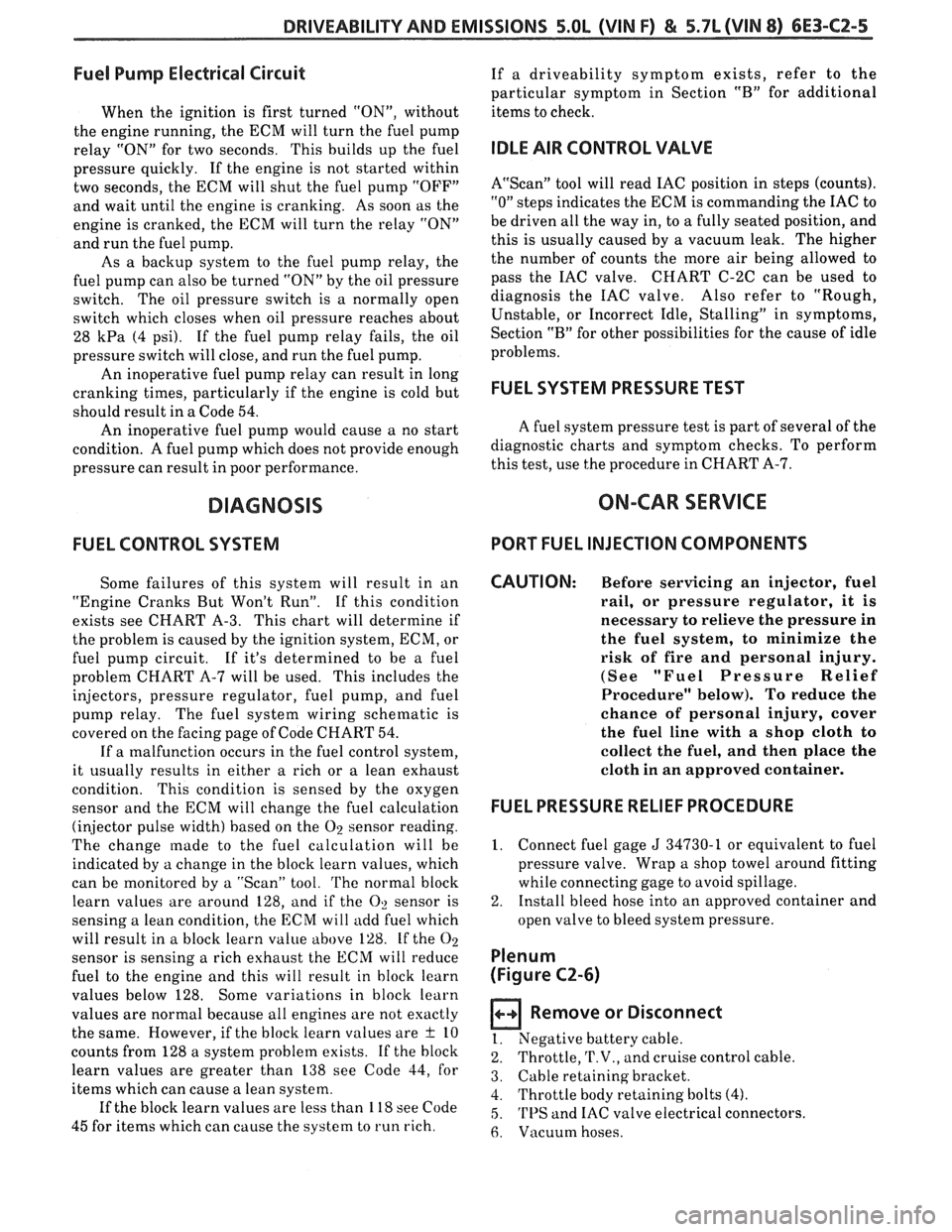
DRIVEABILITY AND EMISSIONS 5.OL (VIN F) & 5.7L (VIN 8) 6E3-C2-5
Fuel Pump Electrical Circuit
When the ignition is first turned "ON", without
the engine running, the ECM will turn the fuel pump
relay "ON" for two seconds.
This builds up the fuel
pressure quickly. If the engine is not started within
two seconds, the ECM will shut the fuel pump "OFF"
and wait until the engine is cranking. As soon as the
engine is cranked, the ECM will turn the relay "ON"
and run the fuel pump.
As
a backup system to the fuel pump relay, the
fuel pump can also be turned "ON" by the oil pressure
switch. The oil pressure switch is a normally open
switch which closes when oil pressure reaches about
28
kPa (4 psi). If the fuel pump relay fails, the oil
pressure switch will close, and run the fuel pump.
An inoperative fuel pump relay can result in long
cranking times, particularly if the engine is cold but
should result in
a Code 54.
An inoperative fuel pump would cause a no start
condition. A fuel pump which does not provide enough
pressure can result in poor performance.
DIAGNOSIS
FUEL CONTROL SYSTEM
Some failures of this system will result in an
"Engine Cranks But Won't Run". If
this condition
exists see CHART A-3. This chart will determine if
the problem is caused by the ignition system, ECM, or
fuel pump circuit. If
it's determined to be a fuel
problem CHART A-7 will be used. This includes the
injectors, pressure regulator, fuel pump, and fuel
pump relay. The fuel system wiring schematic is
covered on the facing page of Code CHART 54.
If a malfunction occurs in the fuel control system,
it usually results in either a rich or
a lean exhaust
condition. This condition is sensed by the oxygen
sensor and the ECM will change the fuel calculation
(injector pulse width) based on the
O2 sensor reading.
The change
made to the fuel calculation will be
indicated by a change in the block learn values, which
can be monitored by a "Scan" tool.
The normal block
learn values are around 128, and if the
O2 sensor is
sensing a lean condition, the EC
M will add fuel which
will result in a block learn value above 128.
If the O2
sensor is sensing a rich exhaust the ECM will reduce
fuel to the engine and this will result in block learn
values below 128. Some variations in block
learn
values are normal because all engines are not exactly
the same. However, if the block learn values are
+ 10
counts from 128 a system problem exists. If the block
learn values are greater than 138 see Code 44, for
items which can cause a lean system.
If the block learn values are less than 118 see Code
45 for items which can cause the system to run rich. If
a driveability symptom exists, refer to the
particular symptom in Section
"B" for additional
items to check.
IDLE AIR CONTROL VALVE
AUScan" tool will read IAC position in steps (counts).
"0" steps indicates the ECM is commanding the IAC to
be driven all the way in, to a fully seated position, and
this is usually caused by a vacuum leak. The higher
the number of counts the more air being allowed to
pass the IAC valve. CHART C-2C can be used to
diagnosis the IAC valve. Also refer to "Rough,
Unstable, or Incorrect Idle, Stalling" in symptoms,
Section "B" for other possibilities for the cause
of idle
problems.
FUEL SYSTEM PRESSURE TEST
A fuel system pressure test is part of several of the
diagnostic charts and symptom checks. To perform
this test, use the procedure in CHART A-7.
ON-CAR SERVICE
PORT FUEL INJECTION COMPONENTS
CAUTION:
Before servicing an injector, fuel
rail, or pressure regulator,
it is
necessary to relieve the pressure in
the fuel system, to minimize the
risk of fire and personal injury.
(See "Fuel Pressure Relief
Procedure" below). To reduce the
chance of personal injury, cover
the fuel line with
a shop cloth to
collect the fuel, and then place the
cloth in an approved container.
FUEL PRESSURE RELIEF PROCEDURE
1. Connect fuel gage J 34730-1 or equivalent to fuel
pressure valve. Wrap a shop towel around fitting
while connecting gage to avoid spillage.
2. Install bleed hose into an approved container and
open valve to bleed system pressure.
Plenum
(Figure
C2-6)
Remove or Disconnect
1. Negative battery cable.
2. Throttle, 'F.V., and cruise control cable.
3. Cable retaining bracket.
4.
'I'hrottle body retaining bolts (4).
5. 'L'l'S and IAC valve electrical connectors.
6. Vacuum hoses.
Page 893 of 1825
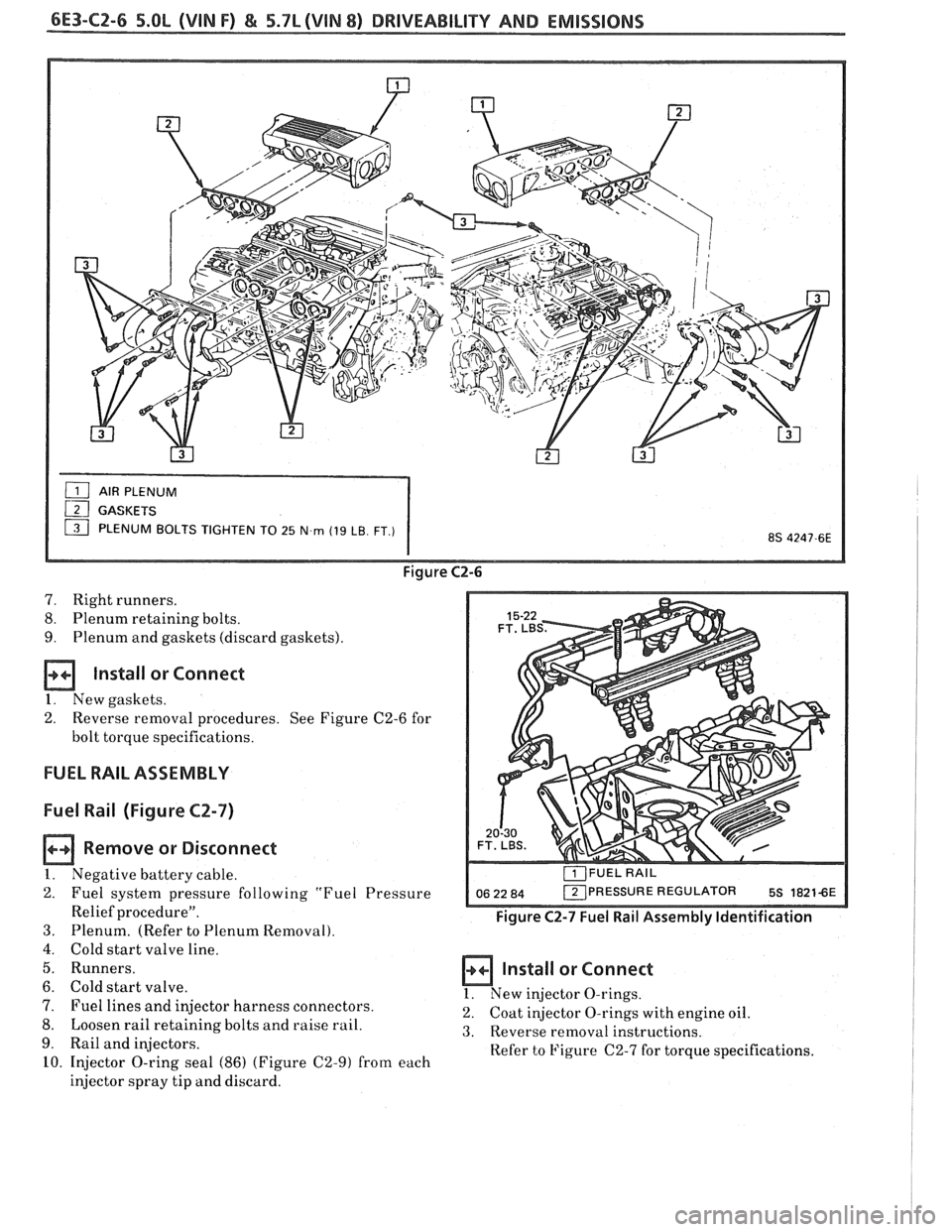
6E3-C2-6 5.OL (VIN F) & 5.7L(VIN 8) DRIVEABILITY AND EMISSIONS
PLENUM BOLTS TIGHTEN TO 25 N m (19 LB. FT.)
Figure C2-6
7. Right runners.
8. Plenum retaining bolts.
9. Plenum and gaskets (discard gaskets).
Install or Connect
1. New gaskets.
2. Reverse removal procedures. See Figure C2-6 for
bolt torque specifications.
FUEL RAIL ASSEMBLY
Fuel Rail (Figure C2-7)
n Remove or Disconnect
1. Negative battery cable
2. Fuel system pressure following "Fuel Pressure
Relief procedure".
3. Plenum. (Refer to Plenum Removal).
4. Cold start valve line.
5. Runners.
6. Cold start valve.
7. Fuel lines and injector harness connectors.
8. Loosen rail retaining bolts and raise rail.
9. Rail and injectors.
10. Injector O-ring seal (86) (Figure C2-9) from each
injector spray tip and discard.
) 06 22 84 PRESSURE REGULATOR 5s 1821SE I
Figure C2-7 Fuel Rail Assembly Identification
Install or Connect
1. New injector O-rings.
2. Coat injector O-rings with engine oil.
3. Reverse removal instructions.
Refer to Figure C2-7 for torque specifications.
Page 894 of 1825
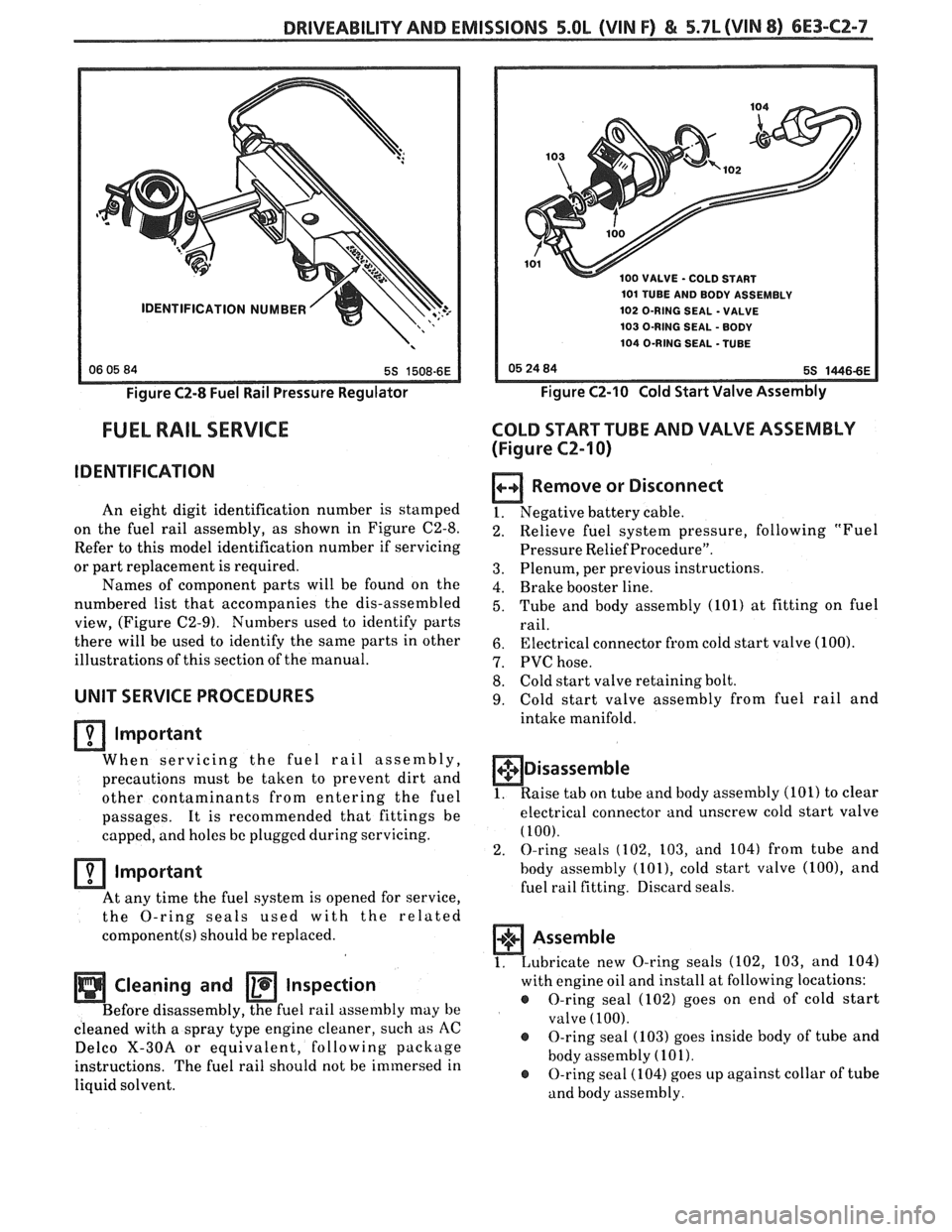
DRIVEABILITY AND EMISSIONS 5.OL (VIN F) & 5.7L (VIN 8) 6E3-C2-7
Figure C2-8 Fuel Rail Pressure Regulator
FUEL RAIL SERVICE
IDENTIFICATION
An eight digit identification number is stamped
on the fuel rail assembly, as shown in Figure C2-8.
Refer to this model identification number if servicing
or part replacement is required.
Names of component parts will be found on the
numbered list that accompanies the dis-assembled
view, (Figure C2-9). Numbers used to identify parts
there will be used to identify the same parts in other
illustrations of this section of the manual.
UNIT SERVICE PROCEDURES
lrnportant
When servicing the fuel rail assembly,
precautions must be taken to prevent dirt and
other contaminants from entering the fuel
passages. It is recommended that fittings be
capped, and holes
be plugged during servicing.
Important
At any time the fuel system is opened for service,
the
O-ring seals ised with the related
component(s) should be replaced.
Cleaning and Inspection
Before disassembly, the fuel rail assenlbly may be
cleaned with a spray type engine cleaner, such as
AC
Delco X-30A or equivalent, following
package
instructions. The fuel rail should not be immersed in
liquid solvent.
0 VALVE - COLD START
101 TUBE AND BODY ASSEMBLY
102 O-RING SEAL
- VALVE
103 O-RING SEAL
- BODY
104 O-RING SEAL -TUBE
Figure CZ-10 Cold Start Valve Assembly
COLD START TUBE AND VALVE ASSEMBLY
(Figure
CZ-I 0)
Remove or Disconnect
1. Negative battery cable. -
Relieve fuel system pressure, following "Fuel
Pressure Relief Procedure".
Plenum, per previous instructions.
Brake booster line.
Tube and body assembly (101) at fitting on fuel
rail.
Electrical connector from cold start valve (100).
PVC hose.
Cold start valve retaining bolt.
Cold start valve assembly from fuel rail and
intake manifold.
+$ Disassemble
1. Raise tab on tube and body assembly (101) to clear
electrical connector and unscrew cold start valve
(100).
2. O-ring seals (102, 103, and 104) from tube and
body assembly
(lOl), cold start valve (loo), and
fuel rail fitting. Discard seals.
1. Lubricate
new O-ring seals (102, 103, and 104)
with engine oil and install at following locations:
@ O-ring seal (102) goes on end of cold start
valve
(100).
@ O-ring seal (103) goes inside body of tube and
body assembly
(101).
@ O-ring seal (104) goes up against collar of tube
and body assembly.
Page 895 of 1825
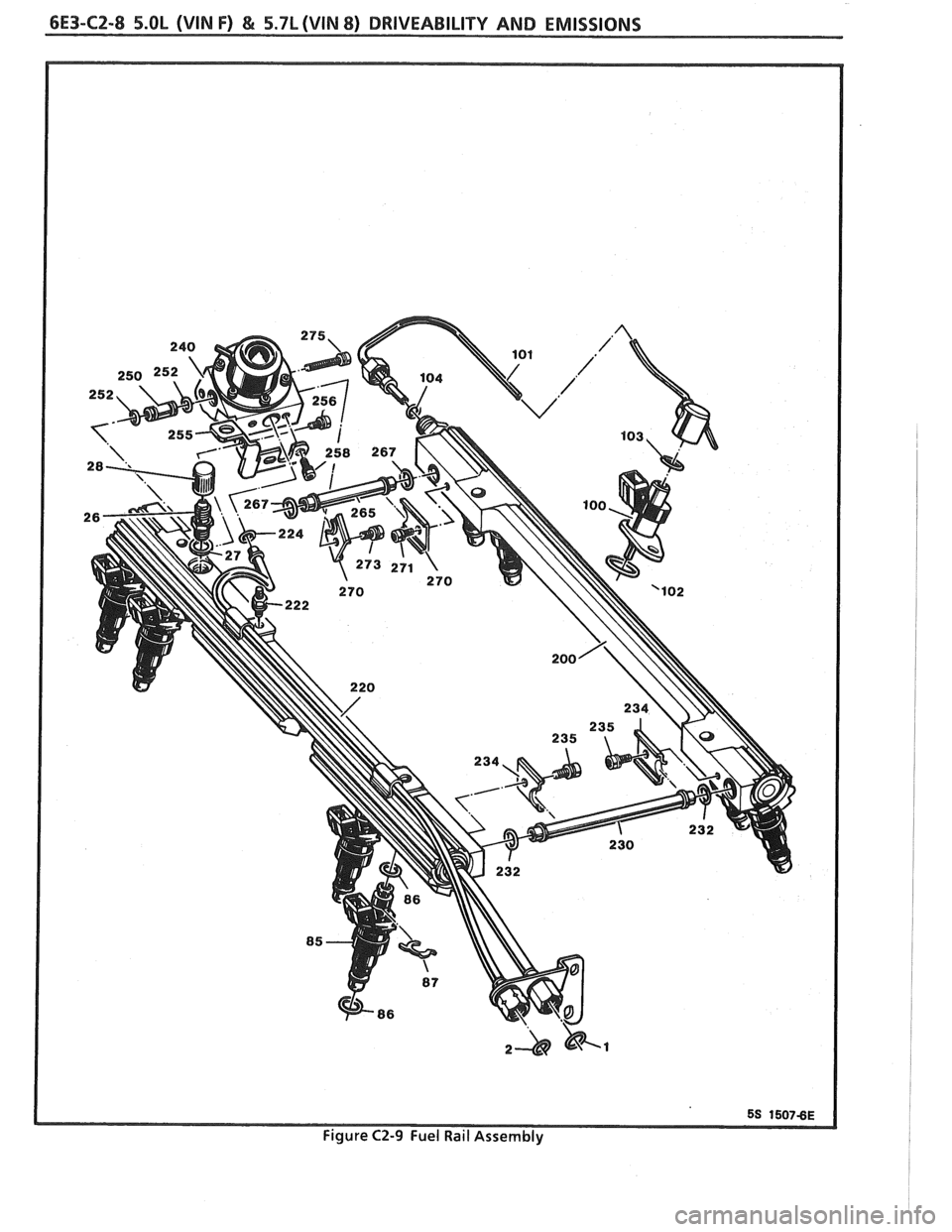
6E3-CZ-8 5.OL (VIN F) & 5.7L(VIN 8) DRIVEABILITY AND EMISSIONS
F~gure C2-9 Fuel Rail Assembly
Page 896 of 1825
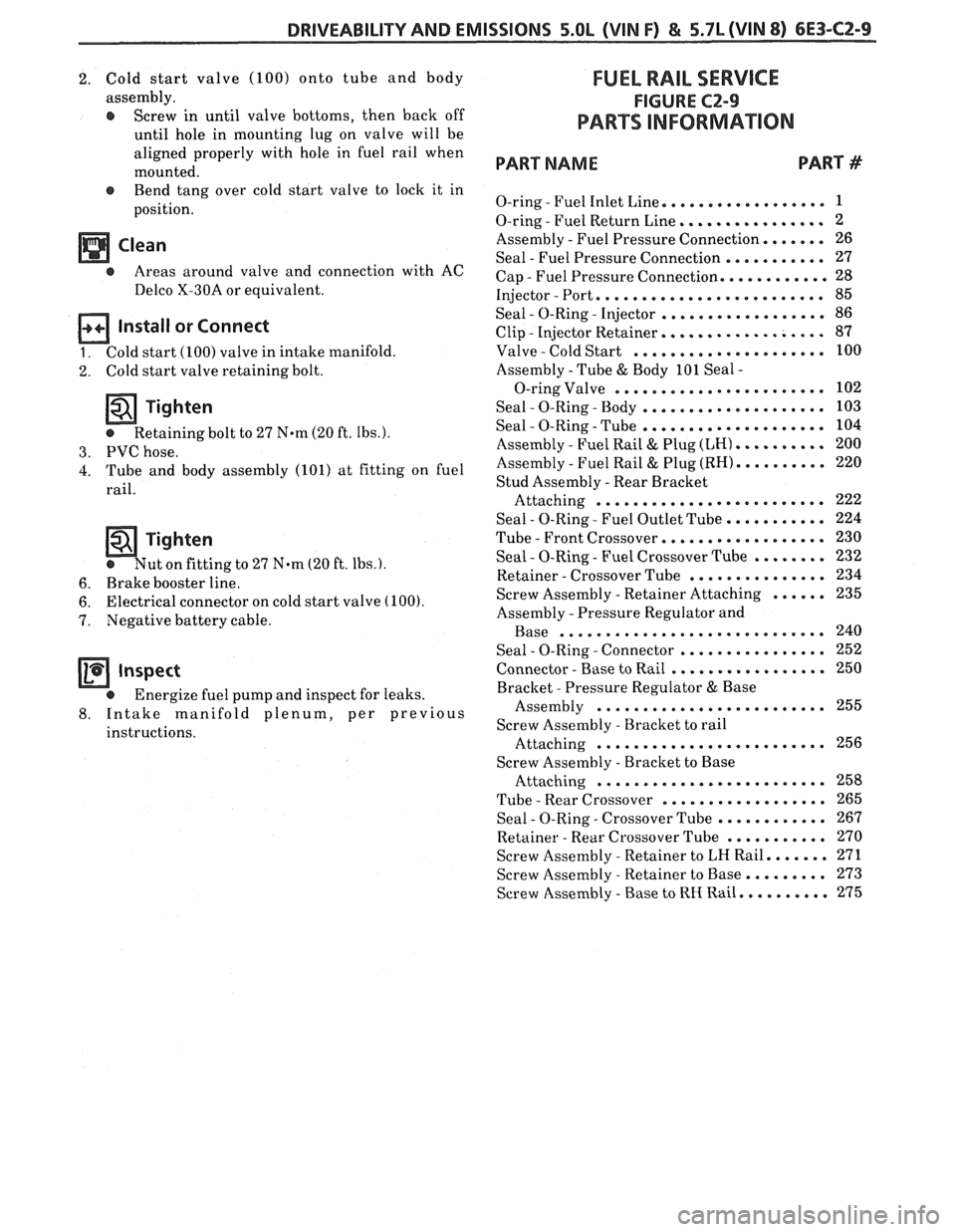
DRIVEABILITY AND EMISSIONS 5.OL (VIN F) & 5.7L (VIN 8) 6E3-CZ-9
Cold start valve (100) onto tube and body
assembly
.
Screw in until valve bottoms. then back off
until hole in mounting lug on valve will be
aligned properly with hole in fuel rail when
mounted
.
@ Bend tang over cold start valve to lock it in
position
.
Clean
@ Areas around valve and connection with AC
Delco X-30A or equivalent
.
Install or Connect
1 . Cold start (100) valve in intake manifold .
2 . Cold start valve retaining bolt .
Tighten
@ Retaining bolt to 27 Nwm (20 ft . lbs.). .
3 . PVC hose .
4 . Tube and body assembly (101) at fitting on fuel
rail
.
Tighten
@ Nut on fitting to 27 N-m (20 ft . lbs.).
6 . Brake booster line .
6 . Electrical connector on cold start valve (100)
7 . Negative battery cable .
Inspect
@ Energize fuel pump and inspect for leaks .
8 . Intake manifold plenum. per previous
instructions
.
FUEL RAIL SERVICE
FIGURE CZ-9
PARTS INFORMAION
PART NAME PART #
. .................. O-ring Fuel Inlet Line 1
. ................ O-ring Fuel Return Line 2
Assembly
. Fuel Pressure Connection ....... 26
Seal
. Fuel Pressure Connection ........... 27
Cap
. Fuel Pressure Connection ............ 28
Injector
. Port ......................... 85
. . .................. Seal 0-Ring Injector 86
. .................. Clip Injector Retainer 87
. ..................... Valve Cold Start 100
Assembly
. Tube & Body 101 Seal .
....................... O-ring Valve 102
. . .................... Seal 0-Ring Body 103
. . .................... Seal 0-Ring Tube 104
. .......... Assembly Fuel Rail & Plug (LH) 200
. .......... Assembly Fuel Rail & Plug (RH) 220
Stud Assembly
. Rear Bracket
......................... Attaching 222
Seal
. 0-Ring . Fuel Outlet Tube ........... 224
. ................. Tube Front Crossover 230
. . ........ Seal 0-Ring Fuel Crossover Tube 232
. .*............. Retainer Crossover Tube 234
...... . Screw Assembly Retainer Attaching 235
Assembly
. Pressure Regulator and
............................. Base 240
. ................ . Seal 0-Ring Connector 252
. ................. Connector Base to Rail 250
Bracket
. Pressure Regulator & Base
......................... Assembly 255
Screw Assembly
. Bracket to rail
......................... Attaching 256
Screw Assetnhly
. Bracket to Base
......................... Attaching 258
. .................. Tube Rear Crossover 265
. . ............ Seal 0-Ring Crossover Tube 267
........... . Retainer Rear Crossover Tube 270
....... . Screw Assembly Retainer to LH Rail 271
......... . Screw Assembly Retainer to Base 273
.......... . Screw Assembly Base to RH Rail 275
Page 897 of 1825
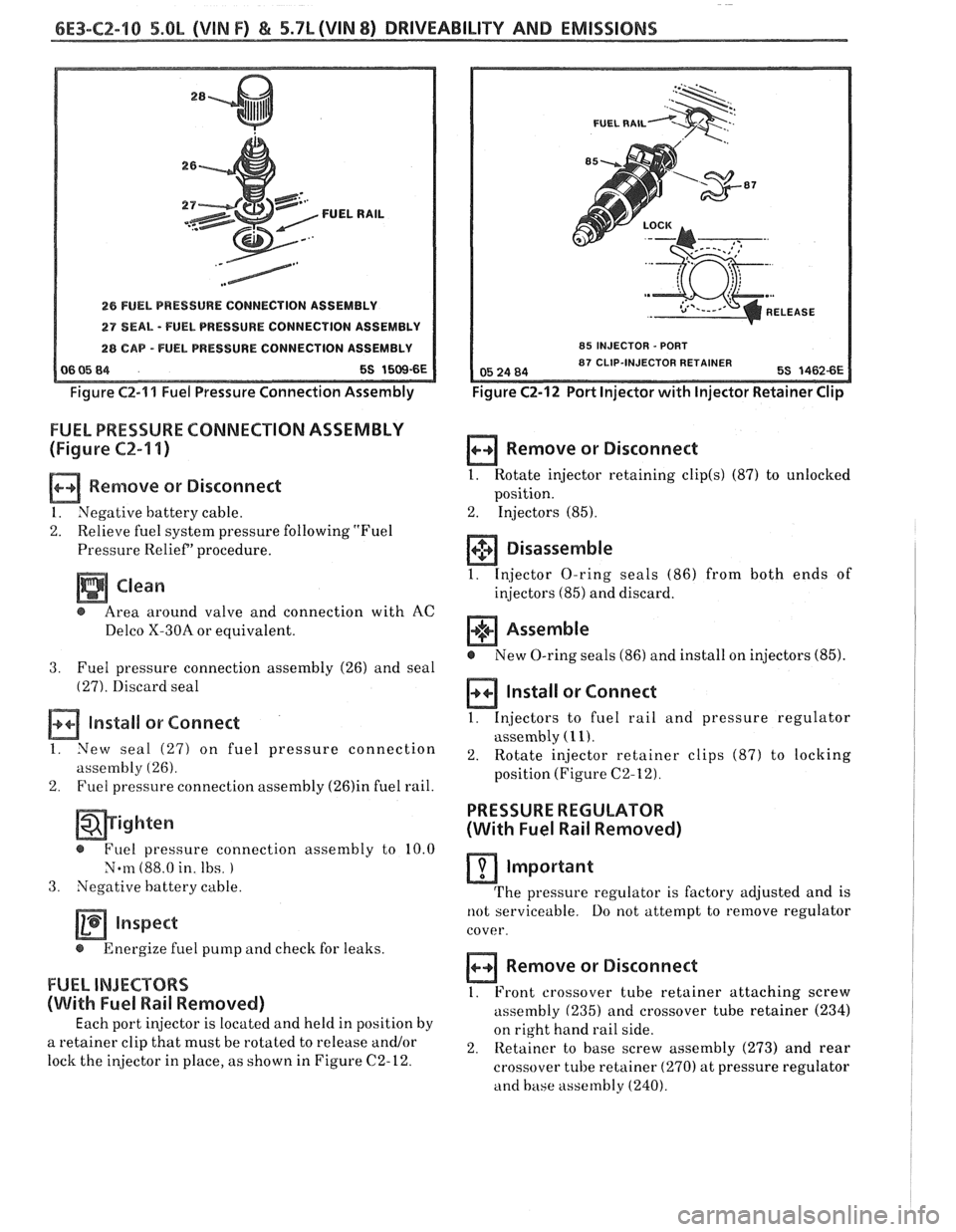
6E3-C2-"l s5.OL (VIN F) & 5.7b (VIN 8) DRIVEABILITY AND EMISSIONS
FUEL RAIL
26 FUEL PRESSURE CONNECTION ASSEMBLY
27 DEAL - FUEL PRESSURE CONNECTION ASSEMBLY
28 CAP -FUEL PRESSURE CONNECTION ASSEMBLY
06 85 84 5S 1509-6E
Figure
C2-'11 Fuel Pressure Connection Assembly
FUEL PRESSURE CONNECTION ASSEMBLY
(Figure
CZ-'I I)
Remove or Disconnect
1. Negative battery cable.
2. Relieve fuel system pressure following "Fuel
Pressure Relief' procedure.
a Clean
@ Area around valve and connection with AC
Delco X-30A or equivalent.
3. Fuel pressure connection assembly (26) and seal
(27). Discard seal
Install or Connect
I. New seal (27) on fuel pressure connection
assembly
(26).
2. Fuel pressure connection assembly (26)in fuel rail.
- @ Fuel pressure connection assembly to 10.0
Norn (88.0 in. Ibs.
3. Negative battery cable.
inspect
@ Energize fuel pump and check for leaks.
FUEL INJECTORS
(With Fuel Wail Removed)
Each port injector is located and held in position by
a retainer clip that must be rotated to release
and/or
lock the injector in place, as shown in Figure (22-12.
FUEL RAIL
I 85 INJECTOR - PORT I
Figure CZ-12 Port Injector with Injector Retainer Clip
a Remove or Disconnect
1. Rotate injector retaining clip(s) (87) to unlocked
position.
2. Injectors (85).
+$ Disassemble
1. Injector O-ring seals (86) from both ends of
injectors
(85) and discard.
Assemble
@ New O-ring seals (86) and install on injectors (85).
Install or Connect
1. Injectors
to fuel rail and pressure regulator
assembly
(1 1).
2. Rotate
injector retainer clips (87) to loclring
position (Figure C2-12).
PRESSURE REGULATOR
(With Fuel Rail Removed)
Important
The pressure regulator is factory adjusted and is
not serviceable. Do not attempt to remove regulator
cover.
Remove or Disconnect
1. Front crossover tube retainer attaching screw
assembly
(235) and crossover tube retainer (234)
on right hand rail side.
2. Retainer to base screw assembly (273)
and rear
crossover tube retainer
(270) at pressure regulator
and base assembly (240).
Page 898 of 1825
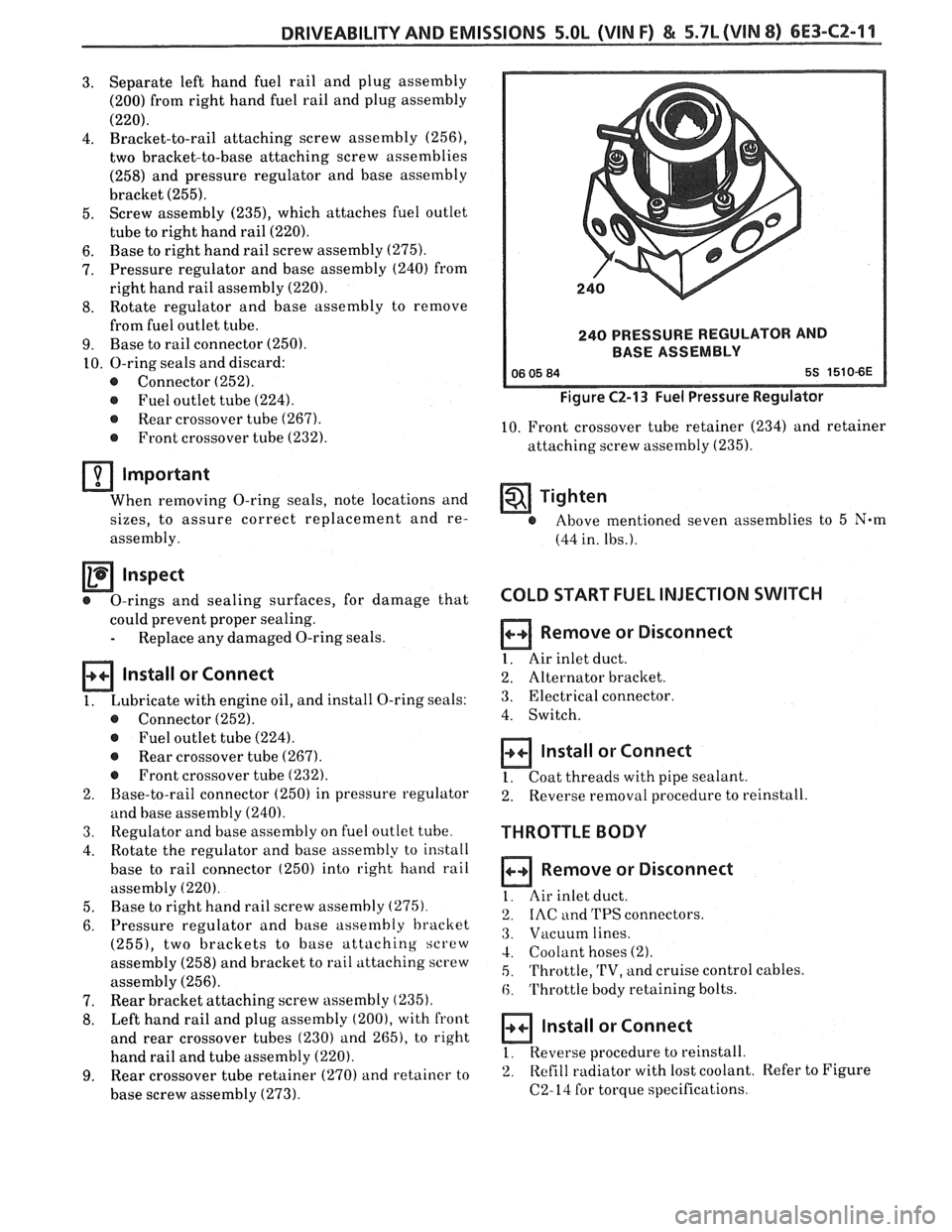
DRIVEABILITY AND EMISSIONS 5.OL (VIN F) & 5.7L (VIN 8) 6E3-C2-11
3. Separate left hand fuel rail and plug assembly
(200) from right hand fuel rail and plug assembly
(220).
4. Bracket-to-rail
attaching screw assembly (256),
two bracket-to-base attaching screw assemblies
(258) and pressure regulator and base assembly
bracket
(255).
5. Screw
assembly (235), which attaches fuel outlet
tube to right hand rail (220).
6. Base to right hand rail screw assembly (275).
7. Pressure regulator and base assembly (240) from
right hand rail assembly (220).
8. Rotate regulator and base assembly to remove
from fuel outlet tube.
9. Base to rail connector (250).
10. O-ring seals and discard:
@ Connector (252).
@ Fuel outlet tube (224).
@ Rear crossover tube (267).
@ Front crossover tube (232).
Important
When removing O-ring seals, note locations and
sizes, to assure correct replacement and re-
assembly.
Inspect
@ O-rings and sealing surfaces, for damage that
could prevent proper sealing.
- Replace any damaged O-ring seals.
n Install or Connect
1. Lubricate with engine oil, and install O-ring seals:
@ Connector (252).
@ Fuel outlet tube (224).
@ Rear crossover tube (267).
@ Front crossover tube (232).
Base-to-rail connector (250) in pressure regulator
and base assembly (240).
Regulator and base assembly on fuel outlet tube.
Rotate the regulator and base assembly to install
base to rail connector
(250) into right hand rail
assembly
(220).
Base to right hand rail screw assembly (275).
Pressure regulator and base assembly bracket
(2551, two brackets to base attaching screw
assembly (258) and bracket to rail attaching screw
assembly (256).
Rear bracket attaching screw assembly
(235).
Left hand rail and plug assembly (2001, with front
and rear crossover tubes (230) and
265), to right
hand rail and tube assembly
(220).
Rear crossover tube retainer (270) and retainer to
base screw assembly
(273).
240PRESSUREREGUbATORAND
BASE ASSEMBLY
Figure C2-13 Fuel Pressure Regulator
10. Front crossover tube retainer (234) and retainer
attaching screw assembly
(235).
Tighten
@ Above mentioned seven assemblies to 5 N-m
(44 in. lbs.).
COLD START FUEL INJECTION SWITCH
Remove or Disconnect
1. Air inlet duct.
2. Alternator bracket.
3. Electrical connector
4. Switch.
Install or Connect
1. Coat threads with pipe sealant.
2. Reverse
removal procedure to reinstall.
THROTTLE BODY
Remove or Disconnect
I. Air inlet duct.
2. IAC and 'I'PS connectors.
3. Vacuum lines.
4. Coolant hoses (2).
5. 'I'hrottle, 'L'V, and cruise control cables.
6. Throttle body retaining bolts.
a Install or Connect
1, Reverse procedure to reinstall.
2. Refill
radiator with lost coolant. Refer to Figure
C2-14 for torque specifications.
Page 899 of 1825
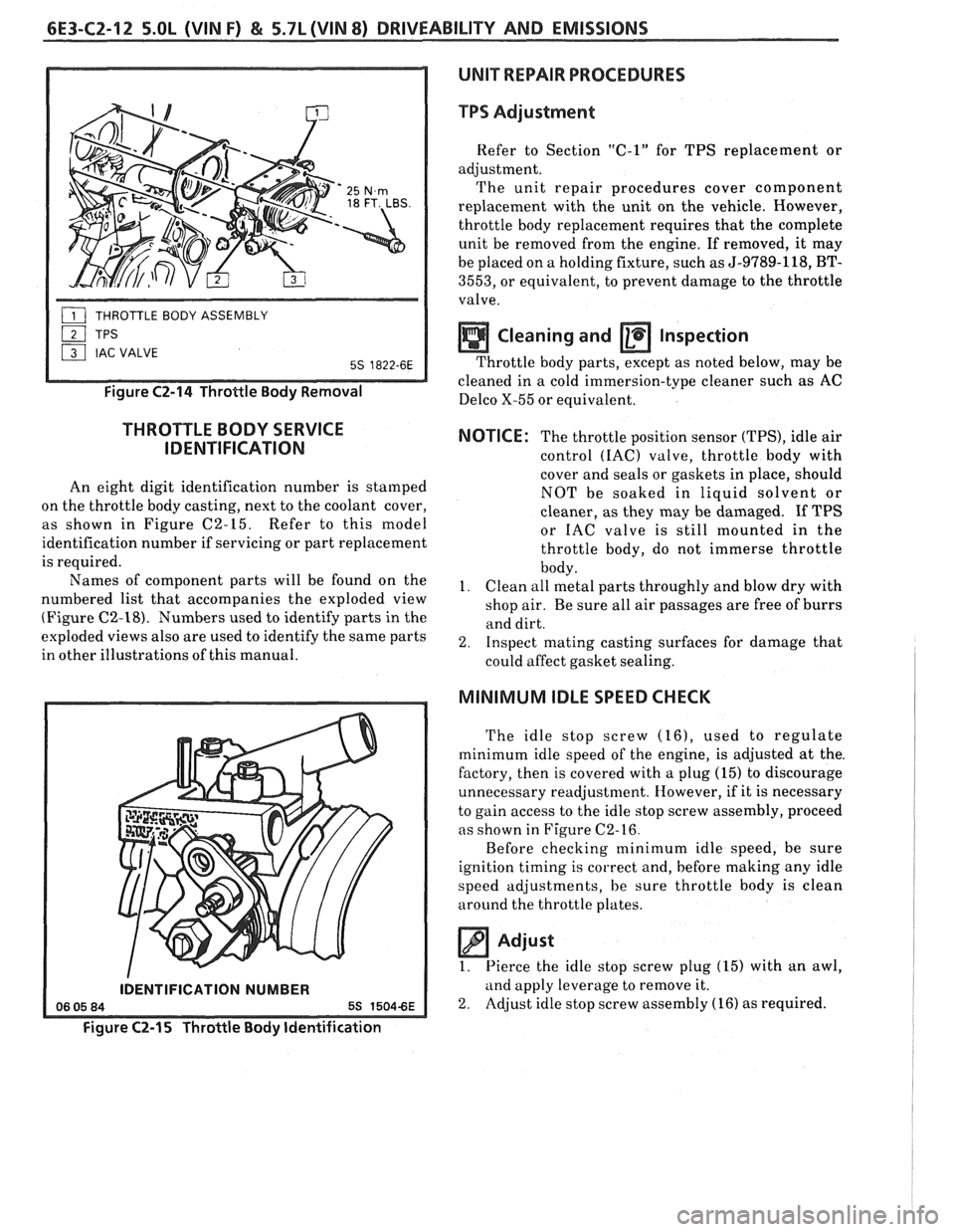
6E3-C2-12 5.OL (VIN F) & 5.7L (VIN 8) DRIVEABILITY AND EMISSIONS
UNIT REPAIR PROCEDURES
Figure C2-14 Throttle Body Removal
THROTTLE BODY SERVICE
IDENTIFICATION
An eight digit identification number is stamped
on the throttle body casting, next to the coolant cover,
as shown in Figure C2-15. Refer to this model
identification number if servicing or part replacement
is required.
Names of component parts will be found on the
numbered list that accompanies the exploded view
(Figure
C2-18). Numbers used to identify parts in the
exploded views also are used to identify the same parts
in other illustrations of this manual.
IDENTIFICATION NUMBER
Figure C2-15 Throttle Body Identification
TPS Adjustment
Refer to Section "C-1" for TPS replacement or
adjustment. The unit repair procedures cover component
replacement with the unit on the vehicle. However,
throttle body replacement requires that the complete
unit be removed from the engine. If removed, it may
be placed on a holding fixture, such as
5-9789-118, BT-
3553, or equivalent, to prevent damage to the throttle
valve.
Cleaning and a Inspection
Throttle body parts, except as noted below, may be
cleaned in a cold-immersion-type cleaner such
a; AC
Delco X-55 or equivalent.
NOTICE: The throttle position sensor (TPS), idle air
control
(IAC) valve, throttle body with
cover and seals or gaskets in place, should
NOT be soaked in liquid solvent or
cleaner, as they may be damaged. If TPS
or IAC valve is still mounted in the
throttle body, do not immerse throttle
body.
I. Clean all metal parts throughly and blow dry with
shop air. Be sure all air passages are free of burrs
and dirt.
2. Inspect mating casting surfaces for damage that
could affect gasket sealing.
MINIMUM IDLE SPEED CHECK
The idle stop screw (161, used to regulate
minimum idle speed of the engine, is adjusted at the.
factory, then is covered with a plug (15) to discourage
unnecessary readjustment. However, if it is necessary
to gain access to the idle stop screw assembly, proceed
as shown in Figure C2-16.
Before checking minimum idle speed, be sure
ignition timing is correct and, before making any idle
speed adjustments, be sure throttle body is clean
around the throttle plates.
Adjust
1. Pierce
the idle stop screw plug (15) with an awl,
and apply leverage to remove it.
2. Adjust idle stop screw assembly
(16) as required.
Page 900 of 1825
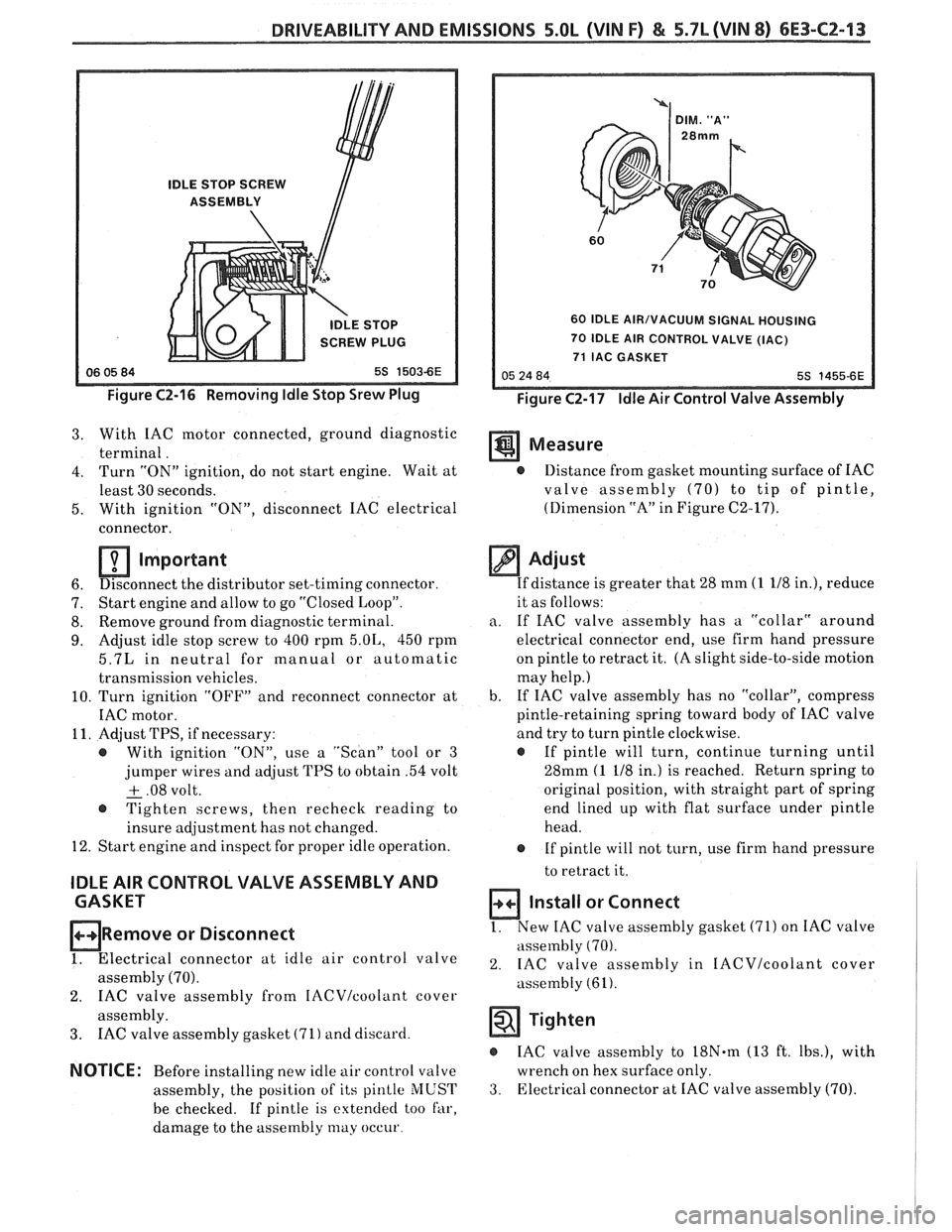
DRIVEABILITY AND EMISSIONS 5.OL (VIN F) & 5.7b (VIN 8) 6E3-CZ-13
IDLE STOP SCREW
ASSEMBLY
IDLE STOP
SCREW PLUG
Figure C2-16 Removing Idle Stop Srew Plug
60 IDLE AIR/VACUUM SIGNAL HOUSING
70 IDLE AIR CONTROL VALVE (IAC)
71 IAC GASKET
Figure C2-17 Idle Air Control Valve Assembly
3. With IAC motor connected, ground diagnostic
terminal. Measure
4. Turn "ON" ignition, do not start engine. Wait at @ Distance from gasket mounting surface of IAC
least 30 seconds. valve assembly
(70) to tip of pintle,
5. With ignition
"ON", disconnect IAC electrical (Dimension
"A" in Figure C2-17).
connector.
Important
6. Disconnect
the distributor set-timing connector.
7. Start
engine and allow to go "Closed Loop".
8. Remove
ground from diagnostic terminal.
9. Adjust idle stop screw to 400 rpm 5.01,, 450 rpm
5.7L in neutral for manual or automatic
transmission vehicles.
10. Turn ignition "OFF" and reconnect connector at
IAC motor.
11. Adjust TPS, if necessary:
@ With ignition "ON", use a "Scan" tool or 3
jumper wires and adjust TPS to obtain .54 volt
+ .08 volt. - @ Tighten screws, then recheck reading to
insure adjustment has not changed.
12. Start engine and inspect for proper idle operation.
IDLE AIR CONTROL VALVE ASSEMBLY AND
CASKET
ORemove or Disconnect
1. Electrical connector at idle air control valve
assembly (70).
2. IAC valve assembly from IACVIcoolant cover
assembly.
3. IAC valve assembly gasket (71) and discard.
NOTICE: Before installing new idle air control valve
assembly, the position of its
pinlle MUST
be checked. If pintle is extended too far,
damage to the assembly
may occur
Adjust
If distance is greater that 28 mm (1 118 in.), reduce
it as follows:
a. If IAC valve assembly has a "collar" around
electrical connector end, use firm hand pressure
on pintle to retract it. (A slight side-to-side motion
may help.)
b. If
IAC valve assembly has no "collar", compress
pintle-retaining spring toward body of IAC valve
and try to turn pintle clockwise.
@ If pintle will turn, continue turning until
28mm
(1 118 in.) is reached. Return spring to
original position, with straight part of spring
end lined up with flat surface under pintle
head.
@ If pintle will not turn, use firm hand pressure
to retract it.
Install or Connect
1. New IAC valve assembly gasket (71) on IAC valve
assembly
(70).
2. IAC valve assembly in IACVIcoolant cover
assembly (61).
Tighten
IAC valve assembly to 18N.m (13 ft. Ibs.), with
wrench on hex surface only.
3. Electrical connector at IAC valve assembly (70).